From low-power consumer electronics to small implanted medical devices, short-distance wireless power transmission already has significant and very useful advantages due to the absence of cables. However, our patent landscape analysis reveals a possible future for the technology that could forever revolutionize how we use electricity, as Senior Consultant in Business Intelligence and Chemistry Practice Team Leader Nicolas Nowak explains
Over the last few decades, energy and data have become critical to our everyday lives. Just as our use and reliance on electronic devices has evolved, so has technology, with data moving from 'wired' to increasingly 'wireless', democratizing access to information. What if we could do the same with access to energy?
What Is Wireless Power Transmission?
Wireless power transmission, also known as wireless energy (transmission) or wireless power transfer (WPT), is a technology that allows electrical energy to be transmitted from a power source to an electrical device without the need for physical connectors or wires.
Today, this technology is mostly used for charging smartphones and electric toothbrushes, as well as some implanted medical devices and, more marginally, some electric vehicles (EVs).
How does wireless power transmission work?
-
In theory:
Wireless charging works on the principle of electromagnetic induction and starts with the wonderful properties of electromagnetic waves.
As we learned early in physics class, if two waves that have the same frequency and are up and down at the same time come together at some point in space, they will add and make a wave that's twice the height and carries four times the energy, because of constructive interference. But, if the same two waves come together at some other place in space, and one is running half a period late, they will cancel each other, resulting in no signal because of destructive interference. This works for all kinds of waves: light, acoustic (this is the principle of noise-canceling headphones), or radiofrequency waves, for example.
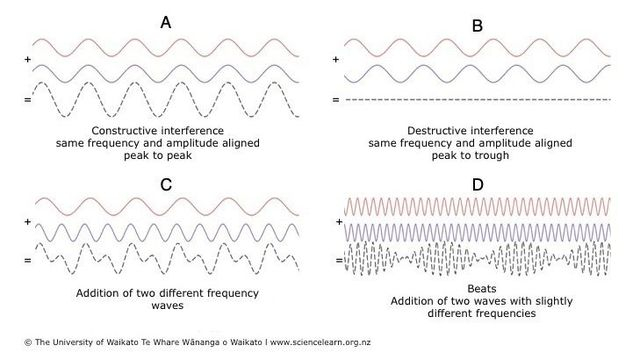
Figure 1: Constructive and destructive
interference
Understanding this concept is important for the purposes of wireless power transmission: if two waves are generated at a certain point, they will propagate and behave as shown in Figure 2, with some points in space having destructive interferences (no energy), and others constructive ones (with more energy), with the number and the intensity of these interferences depending on the distance between the generation points, and the time-difference between their generation.
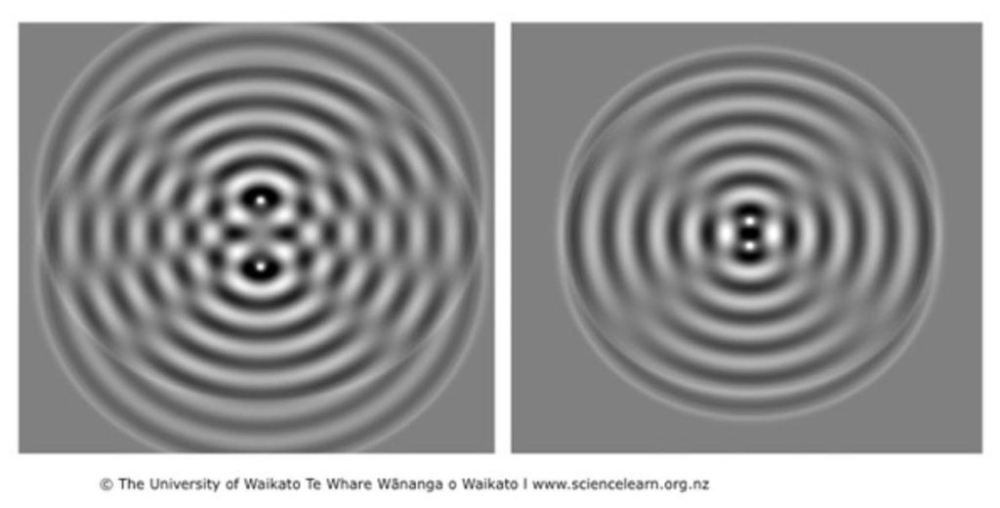
Figure 2: Spatial waves interferences
From there, it is possible to make the waves go in one direction by generating more waves and synchronizing them perfectly in time. What happens then is that most of the energy starts traveling straight down. From there, if the timing is modified, the direction in which the waves with constructive interferences go can be chosen and changed, as illustrated in Figure 3. That direction change can be managed purely by controlling timing, so without any mechanical movement.
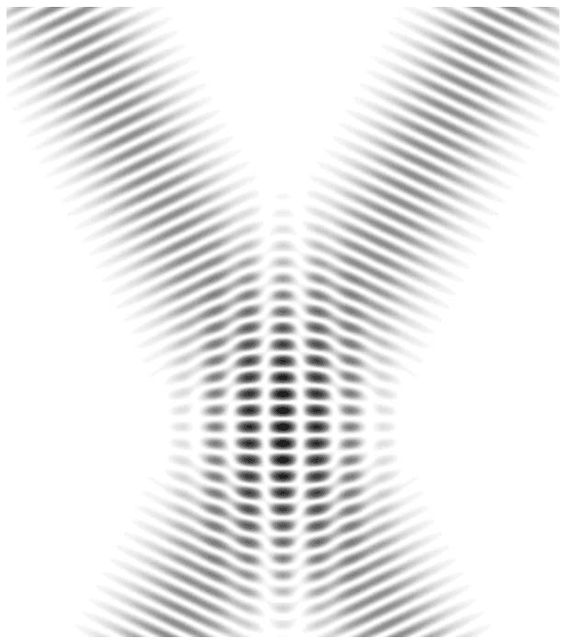
Figure 3: Directional spatial waves
interferences
But this is not where it stops! Controlling the timing between the wave generation also provides another useful feature; this can help send more energy to a point in space of your choosing. So, by perfecting this feature, close to 90% of the energy can be sent to this specific focal point, making it like some kind of magnifying glass for energy. This resonant inductive coupling can be the basis for great improvements in wireless power transmission.
-
In practice:
Practically speaking, wireless power transmission only needs the use of a transmitter induction coil to create the electromagnetic waves from within a charging base, and a receiver induction coil in the targeted device to convert the energy from the electromagnetic field into electric current to charge the battery or power the device. Today, for wireless charging to work efficiently, the transmitter coil and receiver coil need to be close to each other and properly aligned. However, greater distances between sender and receiver coils can be achieved when the resonant inductive coupling system presented earlier is used.
Possible future developments of wireless charging technology
As a relatively new technology, wireless charging is undergoing many different developments that are expected to drive further breakthroughs and advancements in this field. The main research and development (R&D) challenges would now be to:
- Charge multiple devices: In the future, wireless charging systems will have the capability to charge multiple devices simultaneously without each device needing a separate charger. This will enhance the convenience of charging multiple devices, such as smart home devices, electric vehicles, and mobile devices.
- Improve charging speeds and power outputs: This will enable users to charge their devices more quickly, including smartphones, electric vehicles, and other electronic devices.
- Reliably charge electric vehicles: The growth of the electric vehicle market will drive further advancements in this fields, with wireless systems possibly embedded in roads, parking lots, and home garages;
- Use resonant charging: Wireless power transmission technology will continue to develop, allowing for charging over very long distances and increased flexibility without the need for precise alignment with charging pads. But a further objective would be to allow for ultra-long distances power transfer like for space-based solar power systems directing electricity towards the Earth.
If successful, this last area of development could change the electricity supply chain worldwide by generating electricity in space! Solar panels could increase their efficiency four times compared to the best places on earth, thanks to the absence of the atmosphere, nighttime, or clouds. But long-distance wireless power transmission still needs to improve greatly. Although in 2021, a team of researchers sent 1.6 kW of electrical power over a distance of 1 km, with a microwave-to-electricity conversion efficiency of 73%, further tests need to be completed with lower frequency microwaves, which would suffer much less atmospheric loss in space and greater distances.
An important aspect of this potentially disruptive technology is the economic analysis of it. Based on an estimate that a full-sized system solar system would cost £16.3 billion to develop and launch, and allowing for a minimum rate of return on investment of 20% year-on-year, it concluded that a space-based solar-power system could, over its roughly 100-year lifetime, generate energy at £50 per MWh, which is roughly the cost of electricity we have today in Europe.
But obviously, challenges remain numerous and critical to solve. First, energy efficiency needs to be improved a lot for any kind of high-power transfer to minimize energy waste and heat generation. Then safety concerns must be addressed; indeed, it is important to ensure that wireless power transmission methods are safe for both devices and humans is a priority. These concerns are valid for low and high-power applications, but for everyday use, another aspect needs to be addressed; it is the standardization of materials and systems to avoid compatibility issues.
Patent Landscape Analysis of Wireless Power Transmission
Patent filing analysis offers valuable insight into innovation, including helping us to predict the future of technology. In this part, I will share what patent filings for wireless charging innovation can tell us about the next generation of this technology, including the major industry players and main R&D markets behind this innovative solution.
What do patent dynamics tell us about the innovation status of this technology?
To understand the innovation and R&D activities in this technology, we performed a macro search using our proprietary IP intelligence software. By analyzing the patents collected using our IP consulting services expertise, we were able to create a fascinating global insight into research advancement and investment in this field.
In total, the database comprises just over 50,000 patent families filed in the last 20 years. Patent filing dynamics reveal an exponential growth technology for which only just over 200 patents were filled each year 20 years ago, but over 5,000 were filled in 2021, representing a compound annual growth rate (CAGR) of 20%. But the dynamic seems to be slowing these last years, as the CAGR is only at 1% from 2019 to 2021, compared to the expansion phase from 2009 to 2018 that saw almost 28% CAGR.
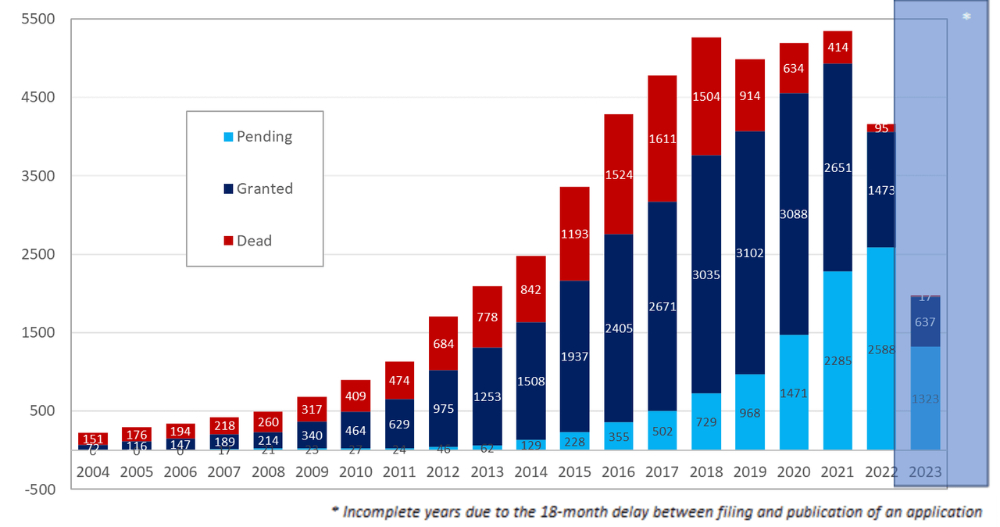
Geographical hotspots for wireless charging innovations
Priority country filing most often occurs in the country in which the R&D is made, so looking at this data shows us which countries are the most innovative and which are the ones that seek to protect their inventions. As is often the case, China is identified as the major country of origin for these wireless charging inventions, with approximately 45% of the total number of patent families.
The U.S. sits in a solid second place, with 22% of patent families, showing the resilience of this country to innovate further in highly technical areas. Korean and Japanese companies follow with around 10% of patents being filed first in these countries. European contribution to research activities is still small, compared to those of Asia and the U.S., and is led mainly by Germany and Great Britain.
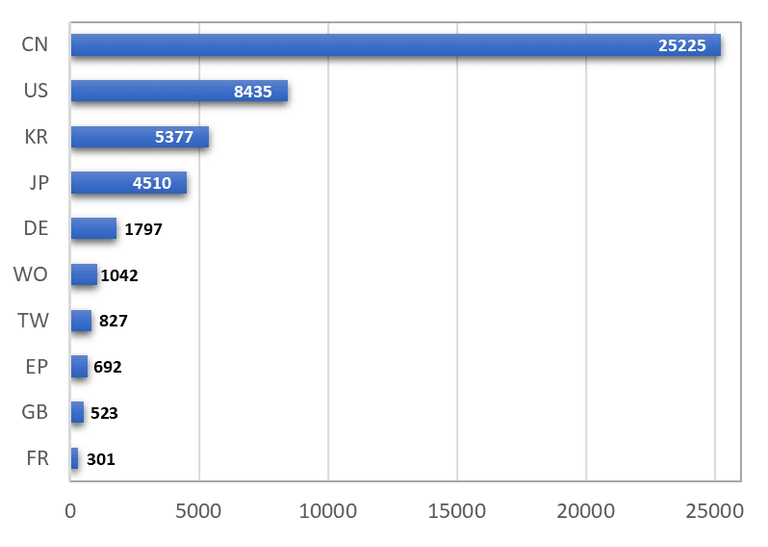
The graph below shows the evolution of the patent filings of the main actors except China. It shows that during the first decade of the period, the U.S. had a strong lead over other countries when looking at patent filings, but this lead decreased against other countries such as Japan and Korea, and for the first time in 2021, Korean filings were more numerous than U.S. ones.
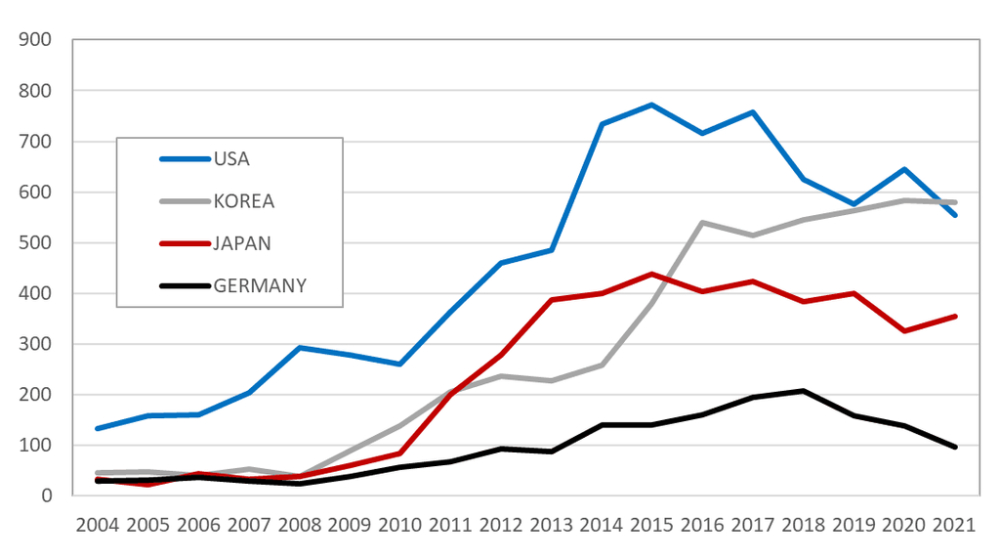
Priority country – filings over the years
2004-2021 (©Questel)
Market coverage for wireless charging innovations
It is no surprise to see the highest number of inventions have been published in the main innovation countries, namely China and the USA. But Europe climbs to third place here as the continent is already very electrified and many future developments can find an important developed and mature market in Europe.
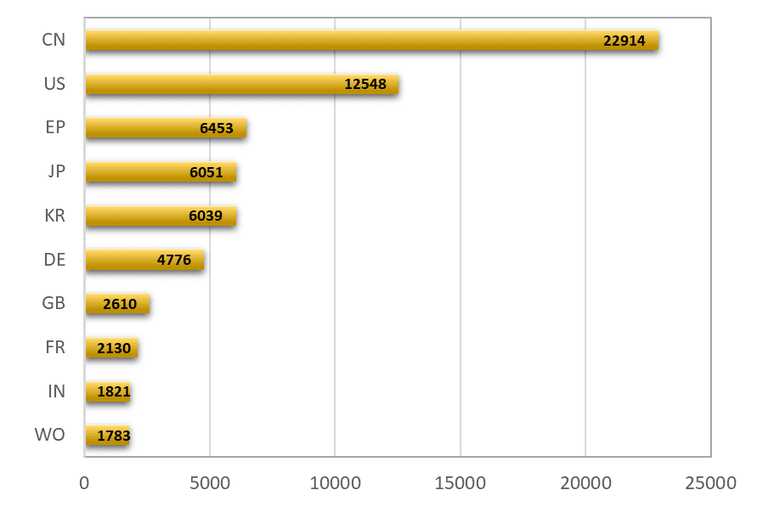
Wireless Power Transmission: Patent Dynamics and Top Players
Major players from the electronics and semiconductors industries can be found among the main innovators in wireless charging. Toyota Motors is the only car manufacturer in the top 50 patent assignees with a solid portfolio of over 500 patent families.
The main contributor is Samsung which owns over 1,800 patent families, 1,600 of them still alive, followed by LG Corporation, with less than half the number of Samsung's patents. WiTricity is an innovative pure player in the field, having specialized in 'future-ready wireless EV charging systems,' and the company has 263 patent families in our database, 230 of them being alive. The company has the highest proportion of granted patents, with 86% of the portfolio being granted.
Other important players are Qualcomm, Apple, The State Grid Corporation of China (SGCC), Canon, and Panasonic, which are all already big companies getting into the field or ensuring a leading position as a visible player in the domain. Most of these companies are active mainly in the mobile device charging field, except for SGCC which owns patents on various aspects of wireless charging for a wide variety of applications.
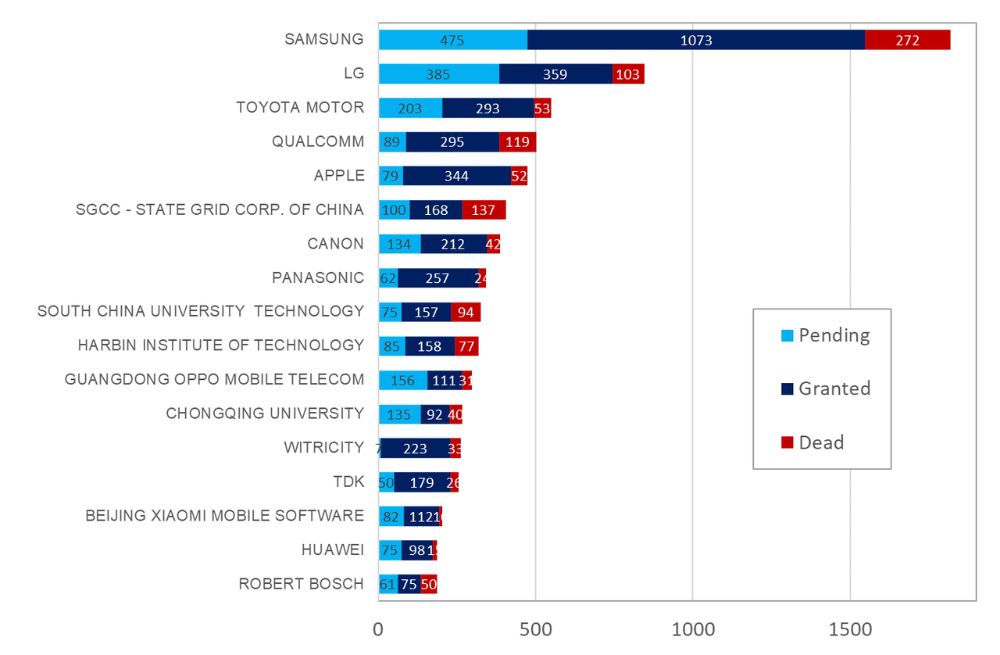
The following table shows the patent activity of some of the main actors in the last six years. Looking at this activity gives some interesting insights about who is joining or abandoning the domain. In the table below, the main actors that have a relatively normal distribution of patent filings considering the global activity (70% in the last 10 years and around 40% in the last six years), such as Samsung or Toyota, are not shown.
When we focus on actors that have been very active recently; we notice the Chinese small electronics players like Oppo, Xiaomi, Huawei and Vivo Mobile, all four of them having filed more than 95% of their portfolio in the last 10 years, and more than 80% during the last six years. This shows the desire of these companies to innovate and propose products with high-value propositions to compete with U.S. and Korean mobile device manufacturers.
Other recent newcomers, having filled more than 85% of their portfolios in the last 10 years, are small companies WiTricity, WiTS, NuCurrent, Energous, and AMOSENSE, although most of these new players, namely Witricity, Energous, and WiTS, have seen their activities drop in the last five years.
- NuCurrent develops wireless power transmission technology based on magnetic induction and magnetic resonance principles which find applications in consumer electronics, wearables, medical devices, automotive, industrial automation, and IoT (Internet of Things) devices.
- Energous is a leading developer of wireless charging and power-at-a-distance technology. Its WattUp platform enables radio frequency (RF)-based wireless charging for various devices, including smartphones, wearables, and IoT devices.
- AMOSENCE is a specialty materials company that uses its expertise to develop components for wireless charging devices, including an ultra-thin magnetic shielding sheet and wireless power transmission antenna module.
- WiTS, Inc. was established in April 2019 after taking over the Samsung Electro-Mechanics mobile wireless power transfer business. Since then, it has been developing wireless transmission receiver modules with antennas for smartphones, wireless transmission modules with antennas for wireless charging pads, NFC chip antennas, etc.
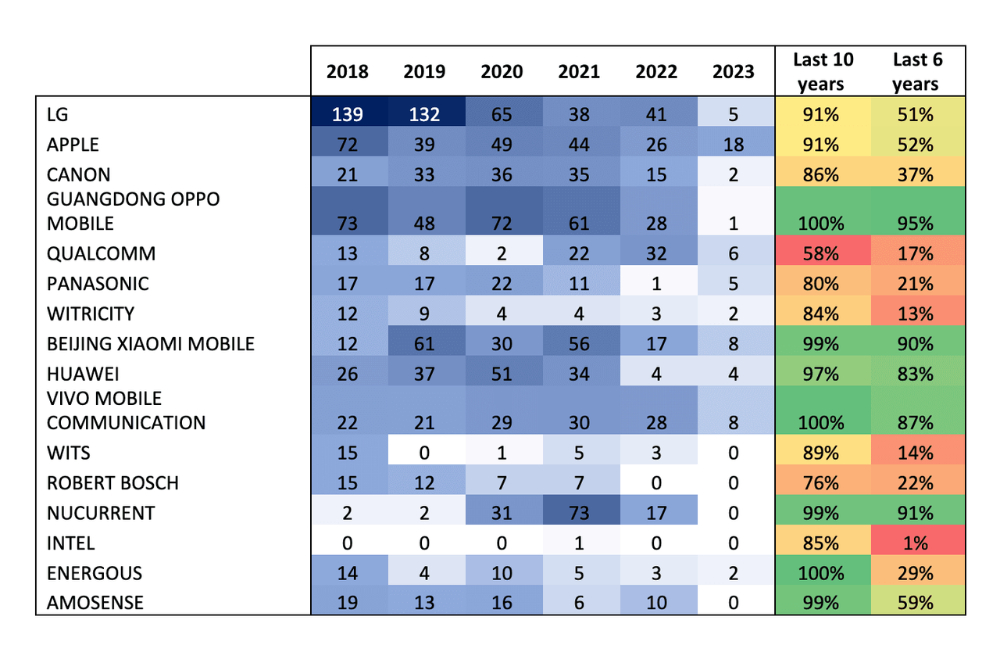
Filing activity of some of the main players over the
years 2018-2023 (©Questel)
Looking at other types of companies in this table, we notice some big names that were active 10 years ago but do not seem to have an interest in the field anymore. In this category, we can place companies, such as Intel, Qualcomm, Robert Bosch, and Panasonic.
The strategy of Qualcomm is interesting to look at, as our software also can show us the impact and the number of non-self-citations of patents, and those numbers are very interesting when comparing the Samsung and Qualcomm portfolios for example.

We can see in this table that Qualcomm owns only a third of the number of granted patents owned by Samsung, but the count of non-self-citations for the U.S. company is higher than for the Korean one. This is taken into account in the "average patent strength" column shown in red above, displaying an average strength of patent families almost 50% higher for Qualcomm than for Samsung. We could assume that Qualcomm now wishes to capitalize on its strength and maybe valorize its portfolio, rather than keep filing patents, for which the yearly maintenance cost is more than US$1.4 million.
Looking briefly at the space applications talked about earlier, we notice a few patents from the California Institute of Technology team led by Pr. Ali Hajimiri, who made a very interesting TED talk on the topic3. This granted patent is related to a large-scale solar power station aimed at being deployed in space, and which power generated can be transferred to Earth via a wireless signal, such as microwave radiation or light.
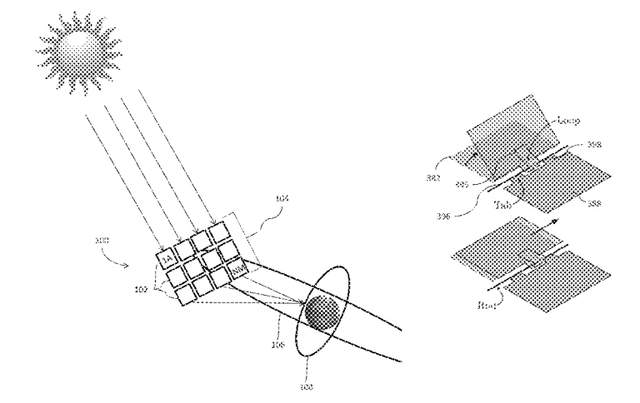
Main image from patent US10340698_B2
In our 50,000+ patents database on wireless energy transfer, there
are only 80 patent families that focus on space-based applications,
with patent applications from assignees, such as NASA, RTX,
Astrium, Redwire Space, and defunct company Escape Dynamics.
Wireless Power Transmission: An Exciting and Fast-Evolving Field
We have seen that wireless charging is a powerful technology based on a time-varying electromagnetic field that allows the transfer of power without requiring a physical connection, and which will keep growing thanks to numerous advantages (no corrosion, higher durability, increased convenience and aesthetics, lower manufacturing costs, etc.). Future improvements will focus on speed, distance, intelligence, eco-friendliness, and standardization of the technology, and each incremental improvement will drive the widespread adoption and application of the technology across various domains, from consumer electronics to transportation, offering people a more convenient, efficient, and environmentally friendly charging experience. Despite the potential of the technology to disrupt the energy paradigm, there is still a long way to go, as only a handful of companies and research institutions appear to have an interest in the field currently. However, this very disruptive idea might only need one working proof-of-concept to get some traction in the patent filings and subsequent commercial activities.
The content of this article is intended to provide a general guide to the subject matter. Specialist advice should be sought about your specific circumstances.

